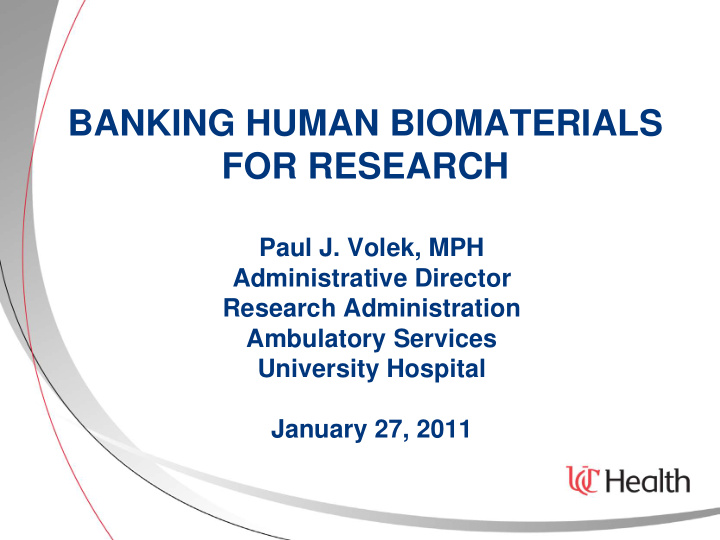



BANKING HUMAN BIOMATERIALS FOR RESEARCH Paul J. Volek, MPH Administrative Director Research Administration Ambulatory Services University Hospital January 27, 2011
Observations on research tissue banking today… • Specimen acquisition has moved from large tissue blocks to small, specially processed, well-characterized specimens • Preservation of gross anatomy has been replaced by preservation of cellular structures and processes • Associated clinical information has as much value as the specimen itself
What need will the bank fill? • Mission-oriented Local demand for research tissue Adjunct to other clinical services or specialty designation Disease-specific Share with other like programs • Revenue generating service-line Full-service Contracts for drug development
PARAFFIN FIXED FIXED BLOCKS DISCARDS BLOCKS FORMALIN AUTOPSY SURGICAL FRESH DISEASED FLUIDS FROZEN OCT BLOOD FLASH FROZEN HEALTHY RNAlater ORGANS ORGAN/TISSUE ARCHIVED DONOR COLLECTIONS TISSUE BLOCKS SLIDES DISCARDS OCULAR Tissue sourcing can be simple or complex – but will always be driven by the end-user
Research tissue banking - surgical • Acquisition for use someday • Limited or broad disease states – specific vs. all tumors • One-size fits all processing and storage – standing order for samples from a want-list • Surgical discards collected and frozen after grossing • Embellishments longitudinal specimen collection following therapy patient information patient and family serum
Research tissue banking - advantages • Cases easily identified • Minimal disruption to Pathology • Standard protocol for processing • Uniform storage requirements • Existing networks for tissue sharing, i.e. simplified distribution • Associated clinical information readily available • Lowest acquisition cost
Research tissue banking - limitations • Guess at most likely future use • Future use dictates recovery and preservation • Focus on volume • Researchers take it or leave it • Missed opportunities for tissue recovery • Limited quantity of tissue available
Research tissue banking - reality • May not meet the needs of most of your researchers Wrong disease Wrong tissue Wrong amount Wrong preservation Who is your customer?
If your researchers are local… What is your commitment to serving them? Try to reserve some capacity for your other internal customers • Surgical path tissue won’t stress the system – it requires a mechanism for surveillance Fold into larger biorepository function Keep preservation to standard techniques – fixed/frozen
• Perioperative tissue recovery is potentially much more complicated Specimen dissection Immediate preservation - RNA preservation, snap freezing Surg Path needs to allow collection of diseased tissue Research coordinators may need to be available for secondary processing Expensive
• Post-mortem tissue recovery • Value of tissue driven by protocol – 12, 18, 24 hrs post- OK? • Preservation generally limited to standard fixation • Advantage in tissue recovery and preparation Specific structures can be isolated/dissected Greater variety of tissue sites can be accessed Normal tissue can be recovered • Low tissue acquisition cost
A word about protocols… Nature of the protocol dictates potential sources • Known diseased tissue - targeted sourcing requires surveillance Surgical discards Autopsy Archived specimens Opportunities for tissue sharing
• Opportunistic tissue recovery - you may never see that disease and/or tissue again Two or three default procurement/preservation protocols Minimum tissue recovery - blood, nodes, liver, brain, etc. • Normal - controls Matched to demographics Non-transplantable organs or tissues Biomaterials recovered from organ donor cases
Nature of the protocol dictates recovery procedures • Whole organ/tissue vs. specific structure • Non-diseased tissue from a variety of sites • Timing - 3 minutes, 3 hours, 12 hours • Quantity - 1 cm 3 , 100 gm, as much as possible • Preparation - diced, sectioned More is not always better
Nature of the protocol dictates preservation • Fresh • Frozen - flash LN 2 , dry ice, ULT • Refrigerate • Fix - formalin or other preservative • RNA preservation media • On-site processing
Expanded opportunities for tissue acquisition and distribution • Networking for surgical tissues • Custom sourcing Proactive - linkage with other repositories Patient advocacy groups Specialized processing • Rare/orphan diseases - meaningful contribution • New products - micro-arrays Same disease/site, many patients Same patient, various sites
Finally, a word about “9 to 5” tissue acquisition • Tissue recovery must occur when both the donor and site are ready - not on demand • Tissue recovery is a hassle; your source doesn’t need the aggravation - you don’t pay enough • Researchers who only accept material from Mon - Thurs, 9 - 3 (when their tech is available) deserve to go hungry • Do you really expect your recovery site to do it for free? Pharma’s willing to pay - can you compete?
Consistency in tissue recovery, processing, storage and retrieval are hallmarks of a successful biomaterials bank But, the best data repository wins!
Recommend
More recommend